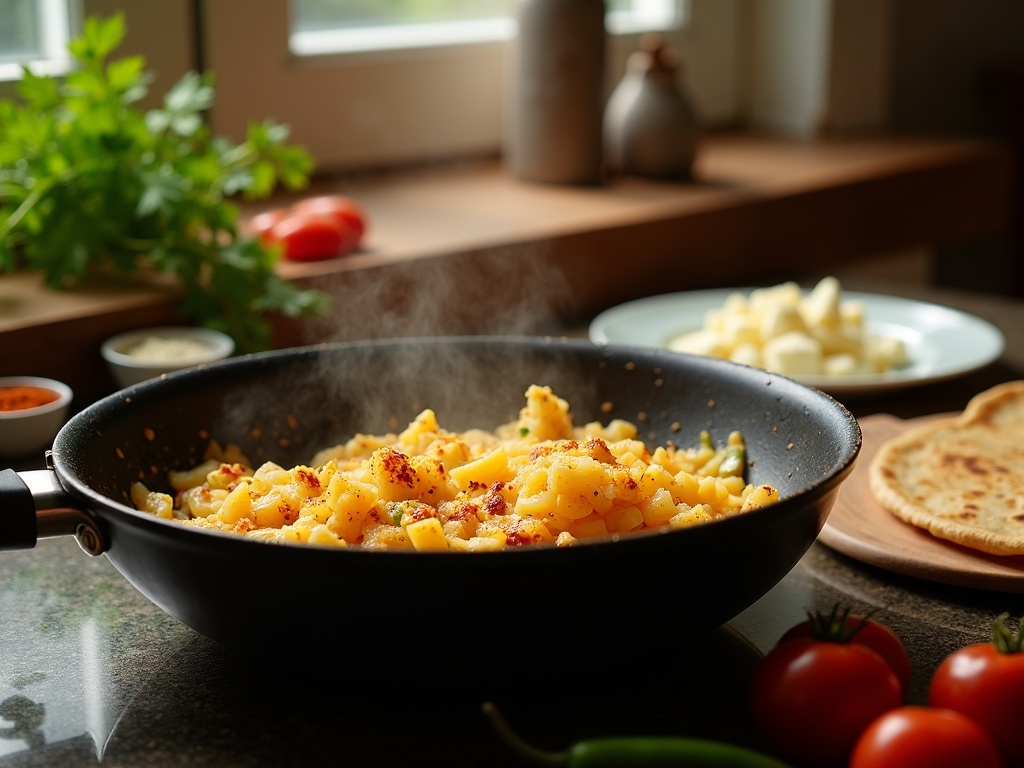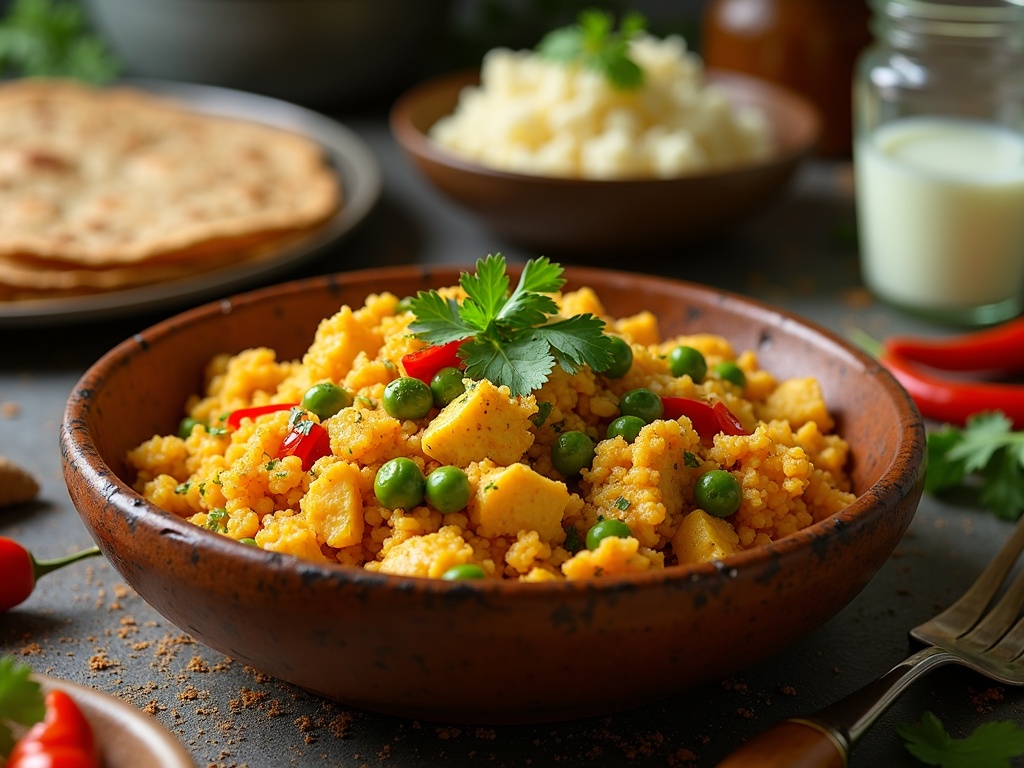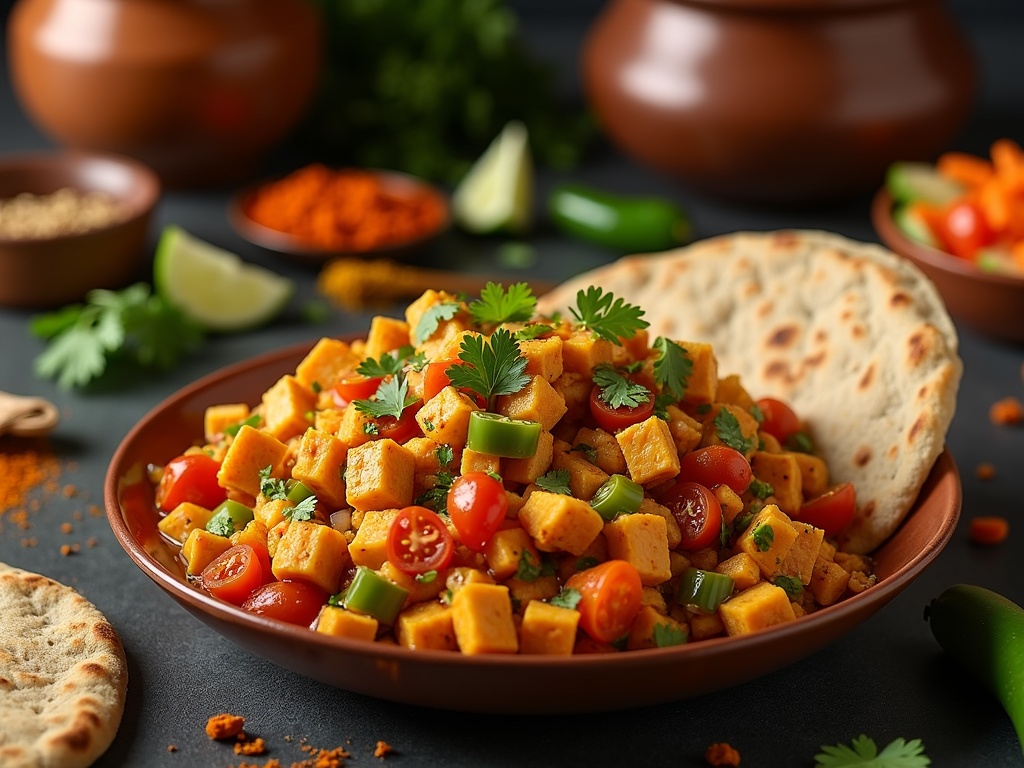Paneer bhurji, a North Indian specialty made with crumbled cottage cheese and aromatic spices, delivers a protein-rich meal in just 15-20 minutes. This adaptable dish packs about 18g of protein per 100g serving, far exceeding other vegetarian protein options while supplying crucial nutrients like calcium and phosphorus for better health.
Find In This Article
Key Takeaways
- Paneer bhurji contains complete protein with all essential amino acids, making it ideal for muscle recovery and weight management.
- The dish is extremely versatile and can be customized with various vegetables like peas, bell peppers, or spinach to enhance nutritional value.
- Traditional preparation involves crumbling fresh paneer and sautéing it with onions, tomatoes, and spices like cumin, coriander, turmeric, and garam masala.
- Paneer bhurji pairs well with whole wheat roti, paratha, bread, or rice, making it suitable for any meal throughout the day.
- Beyond protein, paneer bhurji provides significant calcium for bone health and several essential vitamins and minerals like B12, phosphorus, and zinc.
Why Paneer Bhurji is the Perfect Protein-Packed Meal
I’ve found that paneer bhurji has become my go-to meal when I need something nutritious and satisfying without spending hours in the kitchen. This North Indian delicacy made with crumbled cottage cheese and spices isn’t just delicious—it’s a nutritional powerhouse that deserves a spot in your regular meal rotation.
Impressive Nutritional Profile
Paneer bhurji stands out as an exceptional protein source, especially for vegetarians. With approximately 18g of protein per 100g serving, it significantly outperforms other popular vegetarian protein sources like lentils (9g/100g) and chickpeas (8.4g/100g). This makes it an excellent option for muscle recovery, weight management, and general health maintenance.
Beyond protein, paneer bhurji offers substantial calcium and phosphorus content, supporting bone health and numerous bodily functions. The calcium in paneer is particularly beneficial since it’s readily absorbed by the body due to its dairy source.
What makes paneer bhurji truly special is how it combines these nutritional benefits with incredible flavor. The crumbled texture absorbs spices beautifully, creating a dish that’s both nourishing and satisfying. I often pair it with whole wheat roti or brown rice for a complete meal that keeps me full for hours.
The dish’s versatility is another huge advantage. You can customize your paneer curry experience by adding different vegetables like peas, bell peppers, or spinach. For something more indulgent, a shahi paneer recipe incorporates creamy textures and rich flavors that transform this simple dish into something special.
For busy weeknights, I appreciate that paneer bhurji comes together in just 15-20 minutes from start to finish. This quick preparation time makes it perfect for those evenings when you want something healthy but don’t have the energy for complicated cooking.
The basic recipe involves crumbling fresh paneer and sautéing it with onions, tomatoes, and a blend of spices like cumin, coriander, turmeric, and garam masala. For those who enjoy some heat, a chilli paneer variation adds spicy elements that kick the flavor up several notches.
I’ve found that paneer bhurji fits perfectly into many different dietary approaches:
- For high-protein diets, it provides quality protein without excessive calories
- For balanced eating plans, it combines well with whole grains and vegetables
- For vegetarians, it offers a complete protein source that’s satisfying and versatile
- For meal preppers, it reheats beautifully and can be made in larger batches
If you enjoy the combination of paneer with vegetables, a matar paneer recipe brings sweet green peas into the mix for added fiber, vitamins, and a lovely textural contrast.
The adaptability of paneer bhurji makes it suitable for breakfast, lunch, or dinner. I sometimes prepare it as a protein-rich breakfast alongside whole grain toast, or as a hearty dinner with a side of vegetables and flatbread.
For anyone looking to increase their protein intake while enjoying flavorful, quick-to-prepare meals, paneer bhurji deserves a permanent place in your cooking repertoire. Its nutritional profile, quick preparation time, and incredible taste make it truly one of the most perfect protein-packed meals available.
Everything You Need to Make Perfect Paneer Bhurji
Essential Ingredients
I’ve found that the quality of ingredients makes all the difference when preparing paneer bhurji. This scrambled cottage cheese dish is incredibly flavorful and takes just minutes to prepare with the right components. The star ingredient is 200g of fresh paneer, which should be crumbled by hand rather than cut for the perfect texture. The foundation of flavor comes from 1 tbsp of ghee, though olive oil works as a healthier alternative that still delivers great results.
For the aromatic base, you’ll need 1 medium onion and 1 medium tomato, both finely chopped. The heat level can be customized with 1-2 green chilies, depending on your spice tolerance. I always add 1 tsp of ginger-garlic paste, which infuses the dish with deep, warming flavors that complement the mild paneer beautifully.
Spices and Finishing Touches
The magic of paneer dishes lies in their spice blend. For authentic paneer bhurji, you’ll need ½ tsp cumin seeds to start the tempering process, ½ tsp turmeric for color and earthy notes, and 1 tsp garam masala to bring everything together. Salt should be added to taste, adjusting based on how salty your paneer is.
Fresh coriander leaves are crucial for finishing the dish – they add brightness and color that transforms the appearance and flavor. I can’t stress enough how important fresh ingredients are for making paneer recipes shine. Using newly made paneer rather than packaged varieties will elevate your bhurji from good to exceptional.
The beauty of paneer bhurji is its versatility – it can be served with roti, paratha, or rice for a complete meal. You can also adjust the spice levels or add vegetables like peas or bell peppers to create your own version. For a richer variation similar to chilli paneer, add a splash of cream at the end.
By gathering these ingredients before starting, you’ll set yourself up for a smooth cooking process and a delicious result that’s packed with authentic Indian flavors.
Master Chef’s Guide to Cooking Paneer Bhurji
Creating the perfect paneer curry at home doesn’t have to be complicated. Paneer bhurji, a scrambled version of Indian cottage cheese, is one of the quickest and most flavorful dishes you can prepare. I’ve refined this recipe over years of cooking, and I’m excited to share my step-by-step approach that guarantees delicious results every time.
The Perfect Cooking Process
I always start by heating a tablespoon of oil in a heavy-bottomed pan over medium heat. Once the oil is hot, I add a teaspoon of cumin seeds and let them splutter for about 30 seconds—this releases their earthy aroma and forms the flavor foundation of the dish.
Next comes the onion base. I finely chop one medium onion and sauté it until it turns translucent, which typically takes 3-4 minutes. The key here is patience—rushing this step will rob your shahi paneer recipe of its depth of flavor.
Once the onions are ready, I add a tablespoon of ginger-garlic paste and cook until the raw smell disappears, usually about a minute. This aromatic blend adds a zingy kick that complements the mild paneer perfectly.
The tomato stage follows, where I add two finely chopped tomatoes and 1-2 green chilies (depending on your spice preference). I cook this mixture until the tomatoes soften and start releasing their juices, about 4-5 minutes.
Now for the spice blend: I typically use:
- 1 teaspoon turmeric powder
- 1 teaspoon red chili powder
- 1 teaspoon garam masala
- Salt to taste
After stirring the spices for a minute, I gently fold in about 200 grams of crumbled matar paneer. The secret to a great bhurji texture is breaking the paneer into small, irregular pieces rather than uniform cubes like in chilli paneer.
I cook everything together for another 5-7 minutes, occasionally stirring to prevent sticking and to ensure the paneer absorbs all the flavors. The total cooking time from start to finish is approximately 15-20 minutes.
Just before serving, I sprinkle fresh chopped coriander leaves on top. This final touch adds a burst of freshness that elevates the entire dish. Serve hot with roti, paratha, or even toast for a satisfying meal that comes together in less time than ordering takeout!

From Kitchen to Table: Serving Your Creation
Once I’ve prepared a delicious batch of paneer bhurji, the real joy comes from serving it in ways that highlight its versatility. This traditional breakfast dish holds a special place in Indian households, but I’ve found it works beautifully for any meal throughout the day.
Perfect Pairings
Paneer bhurji creates a satisfying meal when paired with the right accompaniments. I typically serve it with:
- Whole wheat chapati for a traditional breakfast approach
- Flaky parathas that complement the texture of the crumbled paneer
- Toasted bread for a quick fusion-style meal
- Plain steamed rice for a more substantial dinner option
To create a balanced meal, I always include a side of fresh vegetables or a simple salad. The bright, fresh flavors provide a nice contrast to the rich, spiced paneer curry elements in the bhurji.
Cultural Significance
In northern Indian culinary traditions, paneer bhurji holds special importance. I’ve noticed it frequently appears on breakfast tables across Punjab, Delhi, and surrounding regions. The dish has gained popularity because of its straightforward preparation and ability to please nearly everyone at the table.
During festive occasions, paneer bhurji often makes an appearance as part of larger spreads. Its versatility allows it to transition seamlessly from a casual family breakfast to a component in more elaborate meals. I particularly enjoy serving matar paneer alongside bhurji for guests who appreciate paneer in different preparations.
What makes paneer bhurji truly special is its universal appeal. Unlike more complex dishes like chilli paneer or shahi paneer, bhurji’s simplicity makes it accessible to everyone from children to elders. The mild yet flavorful profile means I can adjust spice levels to accommodate different preferences while maintaining the dish’s character.
Whether served as a quick weekday breakfast or as part of a weekend brunch spread, paneer bhurji transitions effortlessly from kitchen to table, bringing with it the comfort and satisfaction that’s characteristic of beloved homestyle Indian cooking.
Health Benefits That Make It Worth Your Time
Paneer bhurji isn’t just a delicious dish; it’s packed with health benefits that make it an excellent addition to your meal rotation. This scrambled paneer preparation combines nutrition with flavor, offering several advantages that support overall wellbeing.
Nutritional Powerhouse for Body Strength
The calcium content in paneer bhurji actively supports bone health, making it particularly valuable for growing children, pregnant women, and older adults. A single serving provides a significant portion of your daily calcium needs, helping to maintain bone density and prevent conditions like osteoporosis.
I’ve found that paneer bhurji is particularly beneficial for fitness enthusiasts due to its complete protein profile. Unlike many plant proteins, paneer contains all essential amino acids needed for muscle repair and growth. This makes it an ideal post-workout meal that aids recovery and supports strength development.
For those mindful about weight management, paneer bhurji can be a friendly option when prepared correctly. I recommend using less oil during preparation and pairing it with fiber-rich vegetables or whole grains. The protein content helps promote satiety, keeping you fuller for longer and potentially reducing overall calorie intake.
Beyond calcium and protein, this dish delivers essential vitamins and minerals that support various bodily functions:
- Vitamin B12 for nerve function and red blood cell formation
- Phosphorus that works with calcium for bone health
- Selenium which acts as an antioxidant
- Zinc for immune function and wound healing
- Vitamin A for vision and immune support
One aspect I appreciate about paneer bhurji is its adaptability. It can fit into various dietary patterns with simple modifications. For a low-carb approach, serve it with cauliflower rice. For a higher-fiber meal, wrap it in whole grain roti. You can even create a luxurious paneer dish by adding a few extra spices and a richer gravy base.
The versatility of paneer bhurji makes it perfect for balanced meal planning. I often prepare a large batch and use it throughout the week in different ways – stuffed in sandwiches, mixed with quinoa, or served alongside roasted vegetables. Its neutral yet flavorful profile pairs well with countless ingredients.
For vegetarians seeking adequate protein sources, paneer bhurji stands out as an excellent option. While many plant-based foods lack one or more essential amino acids, paneer delivers a complete protein package. This makes it comparable to paneer curry and other paneer preparations as a substantial meat alternative.
The dish can be easily customized to increase its nutritional profile. I like adding peas for extra fiber and nutrients, creating something similar to a matar paneer recipe but with the unique texture of scrambled paneer. For those who enjoy spicier food with metabolic benefits, incorporating more chilies creates a variation reminiscent of chilli paneer but in a homestyle format.
For those with specific dietary concerns, paneer bhurji can be prepared with low-sodium spices for heart health, or with added turmeric for anti-inflammatory benefits. The basic recipe serves as an excellent canvas for nutritional customization based on individual health goals.
The combination of protein, fats, and carbohydrates (when served with appropriate sides) makes paneer bhurji a balanced meal option that provides sustained energy. This balance of macronutrients helps regulate blood sugar levels and avoids the energy crashes associated with less balanced meals.

Sources:
The Complete Book of Indian Cooking
Nutrition and Physical Degeneration by Weston A. Price
The Art of Indian Vegetarian Cooking

